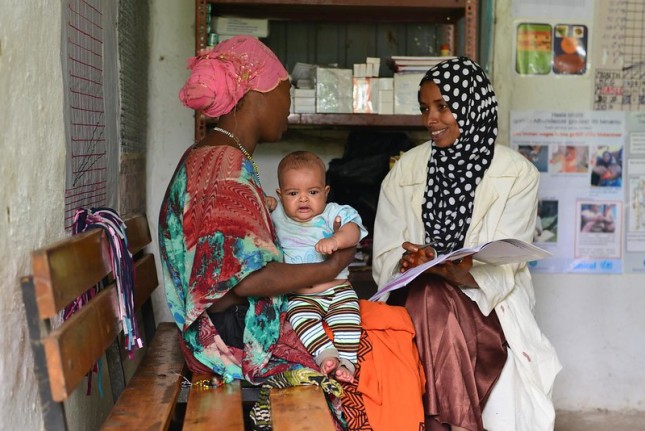-
2023 DOT- MOM Guest Contributor Highlights
November 29, 2023 By Maternal Health Initiative Staff
The Dot-Mom column of the Environmental Change and Security Program’s New Security Beat blog serves as a platform to shed light on diverse perspectives and insights from experts in maternal and reproductive health, gender equity, and peace and security. In 2023, the Dot-Mom column was marked by an incredible number of guest contributor articles.
Among the highlights of the year is an incredible and timely article by Alyssa Kretz, Why We Must Include Pregnant People in Clinical Trials: The Case of the COVID-19 Vaccine. Kretz writes about the importance of including pregnant people in clinical trials to better understand the effects and efficiency of medications and vaccinations during pregnancy. Kretz, who was part of a research team that studied COVID-19 vaccine hesitancy among pregnant people, found that the lack of good data on the side effects of the vaccine was at the center of people’s fears. Inclusion of pregnant people in clinical trials is not just ethical but crucial for empowering clinicians and women with evidence-based information to make informed decisions during pregnancy.
Self-care, as a practice, has gained significant momentum in 2023. Kimberly Whipkey and Molly Browning explore how prioritizing self-care from preconception to the postpartum period can transform the health of pregnant women and their newborns in their article, Me Care, We Care: How Self-Care Strengthens Maternal and Newborn Health. The authors highlight the World Health Organization (WHO) Self-Care Guideline and shed light on how providers in various countries are adopting this guideline in their unique health contexts. In Pakistan, for example, advocates focus on combating maternal anemia through self-administration of iron and folic acid tablets, while in Nigeria, efforts center on preventing postpartum hemorrhage through the self-administration of misoprostol.
Guest contributors Tracey Shissler and Maura McCarthy underscore the urgent need for the eradication of cervical cancer and share some innovative solutions in their article, What Will it Take to Actually Eliminate Cervical Cancer? In Guatemala, health care workers wear show-and-tell aprons illustrating female reproductive anatomy to educate women on self-sampling for screening and in the Philippines, pop-up tents are used to provide privacy to women to self-collect samples to be tested for the human papillomavirus (HPV). More than 95% of cervical cancer is due to HPV and HPV DNA screening detects the presence of HPV, notably types 16 and 18, that are responsible for 70% of cervical cancers. This WHO-recommended technique for cervical cancer screening is particularly efficient in low- and middle-income countries due to its high scalability, accuracy, and acceptability by providers and users.
In another timely article, The Health Burden of the Afghan Woman: Navigating Challenges Amidst Calamity, authors Massoma Jafari, Fatima Jafari, Faiza Rab and Ijia Ormel paint a heartbreaking picture of the profound challenges faced by Afghan women, particularly pregnant people, as they grapple with the aftermath of powerful earthquakes in a country already battling years of armed conflict. The damaged healthcare system, combined with cultural constraints and restrictive Taliban mandates, hinders women’s access to much needed healthcare. This article also sheds light on the important work done by organizations like the Afghan Red Crescent Society and the Afghan Midwifery Association. Such organizations are strategically placed to ensure that essential health services reach women and children impacted by disasters by furthering community-based health promotion programs.
And lastly, Rebecca Levine and Jay Gribble explore the critical role of complementary investments, known as policy, financing, and governance, to improving maternal, newborn, and child health outcomes in their article, Maternal, Newborn and Child Health: Complementary Investments Are Key. Poor quality care has been proven to be a greater obstacle to reducing mortality than insufficient access. Therefore, ensuring sufficient funding to provide a high quality of care to reduce maternal, newborn, and child deaths is critical. Levine and Gribble highlight that in resource-limited countries, inadequate resource allocation and ineffective leadership and governance contribute more to maternal mortality than poverty. Providing a high quality of care and ensuring strong policy, financing, and governance go hand in hand to achieving the Sustainable Development Goals and improving maternal, newborn, and child health outcomes.
We, at the Maternal Health Initiative, look forward to sharing more expert voices in 2024.
- Why We Must Include Pregnant People in Clinical Trials: The Case of the COVID-19 Vaccine by Alyssa Kretz
- Me Care, We Care: How Self-Care Strengthens Maternal and Newborn Health by Kimberly Whipkey & Molly Browning
- What Will it Take to Actually Eliminate Cervical Cancer? by Tracey Shissler and Maura McCarthy
- The Health Burden of the Afghan Woman: Navigating Challenges Amidst Calamity by Massoma Jafari, Fatima Jafari, Faiza Rab and Ijia Ormel
- Maternal, Newborn and Child Health: Complementary Investments Are Key by Rebecca Levine and Jay Gribble
The Dot-Mom column is part of the work of the Wilson Center’s Maternal Health Initiative, which focuses its efforts at the intersection of global health equity and gender equality and their connections to U.S. foreign policy and programming. If you would like to be a guest contributor to the Dot-Mom column on New Security Beat, please send an email of interest with a short (150 words) pitch to mhi@wilsoncenter.org. Please put “Dot-Mom Pitch” in the subject line.
Photo Credit: Health extension worker counsels a woman, who is holding her infant, on best nutrition practices. UNICEF Ethiopia/2014/Nesbitt.
 A Publication of the Stimson Center.
A Publication of the Stimson Center.



